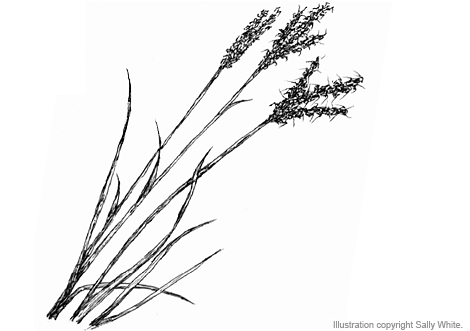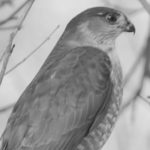Big Bluestem: Plant of the Future
This fall I had an email from a botanist friend: “What’s going on with big bluestem?” After he pointed it out, I noticed that, sure enough, this species, one of the dominant grasses in the tallgrass prairie (as in the source of the original Kansas sods that once housed the homesteaders), is bustin’ out all over the foothills! Big bluestem typically occurs on the slopes of our mountain front, but has been expanding in recent years. In 2010, this warm-season grass had an extraordinary year. Its abundance first drew attention at Lookout Mountain, on the slopes of Windy Saddle Park and adjacent areas, where you can probably still spot patches of its russet fall color when the ground is free of snow, even if you’re driving by on 6th Avenue. If you’re on the Lariat Trail, big bluestem borders the south side of the road east of Windy Saddle. This time of year, when it might seem there’s little to interest plant lovers, big bluestem and its cousins in the grass family provide color in the landscape.
Tallgrass prairie, whether here or in the East, is a tattered remnant of what it was in its glory days. We’re lucky to have sizable patches in Jeffco; efforts to protect some have been underway for more than 20 years. It’s been years since we talked tallgrass prairie here in the PJ newsletter, but the Board has continued to monitor and comment on developments in the Rocky Flats area, where our best examples of this rare ecosystem survive, including the Ranson/Edwards and Jewell Mountain properties. Boulder conveniently protected several hundred acres of the latter. Patches of big bluestem on the foothills slopes are fine, but limited, reminders of the more extensive remnant prairie that once rolled out across the county but has retreated to a fringe along the mountain front. Most of what you see just northwest of Highways 93 and 72 is also tallgrass prairie.
Big Bluestem in Jeffco’s Landscape
Look for these foothills patches primarily on unforested south- and east-facing slopes: on most central slopes visible west of Highway 93, and on the north sides of our canyons, from Bear Creek to Golden Gate. In Mt. Galbraith Park, you can see the colorful auburn patches across the canyon as you make your way up the trail. Driving west on I-70, look for it to the north as you enter the foothills, on the slopes in Matthews-Winters Park. In the southwest part of Red Rocks Park, it occurs on level sites, more prairielike, because that area has been protected and contains isolated spots where the Rocky Flats alluvium has managed to persist on lands that would otherwise have been cultivated or developed. In fall, big bluestem blends perfectly with the outcrops of the Fountain Formation.
Lack of development and a somewhat inhospitable climate have also protected the Rocky Flats area. The extremely cobbly soils, beloved of gravel companies, hampered agricultural attempts on much of the area and enhanced the available moisture content for the growth of these taller species. Because the area is unplowed, in part, these soils are considered among the oldest in Colorado, with some estimates placing their age at 2 million years. But big bluestem’s expression/visibility in the landscape of any given year reflects how we’re doing on overall precipitation and temperature.
The Water Year and Other Influences
Based on the 30-yr average precipitation, our wettest month of the year should be May. When it is, that’s about perfect for big bluestem and other warm-season grasses (including blue grama, sideoats grama, little bluestem, and switchgrass), which are just getting started as the weather warms toward summer. By June, the cool-season grasses (such as the common lawn grasses, including Kentucky bluegrass, which take advantage of early season moisture to start growth) will be ready to flower and set seed, but you’ll still have to hunt around on the ground to find evidence that big bluestem is even alive. Large clumps of hairy, velvety blue-green leaves will be your hint.
In July, those spreading clumps send up tall flowering shoots, which produce the “turkey-foot” seed heads by August. When cool-season grasses are giving it up and their seed has scattered, big bluestem ripens into the terra cotta masses that reveal its presence even from a distance.
This seasonal habit represents an entirely different metabolism (called “C4”) in these plants, which use carbon along different pathways than many familiar plants. According to some researchers, this may give them an advantage under conditions of elevated carbon dioxide (think global climate change), especially during drought. Like many grasses, big bluestem is also adapted to grazing and fire, but not if they occur too frequently.
Interestingly, although it seemed, until recent snows, that it’s been droughty for several months, 2010 was an above average moisture year during its first half, giving big bluestem the start it needed. In fact, rainfall in this part of the county has been at or above normal every month from April 2009 through last June. (Later records have not yet been posted online.) Average temperatures have also hovered a degree or two above normal for several years (except 2008); most of the past decade has been warm. Temperature and moisture conditions have apparently encouraged big bluestem, a species that prefers a little more moisture and warmth than is the rule in Colorado. If we get too dry and warm, we’re apt to see more of its cousin, little bluestem, but as long as it finds a moist spot, big bluestem will remain a part of the county’s natural prospect. If you haven’t seen it, this winter is a great time to go looking for it.
To see temp/precip data go to: http://ccc.atmos.colostate.edu/coloradowater.php
Big Bluestem (grass),
Andropogon gerardii
- Warm-season sod-forming grass.
- Height: 4-5 feet in Colorado, occasionally taller; to 8 ft in prairie states.
- Occurs in all but the five westernmost of the lower 48 states, as well as the central provinces of Canada. Most abundant in eastern Great Plains.
- Dominant and characteristic grass of the tallgrass prairie ecosystem.
- Flowering heads are 4-5 inches long, with 3 (or more) spreading branches, suggesting its other common name: turkeyfoot
Copyright © 2011 Sally L. White
Discover more from PLANJeffco
Subscribe to get the latest posts sent to your email.




Leave a Reply
Want to join the discussion?Feel free to contribute!